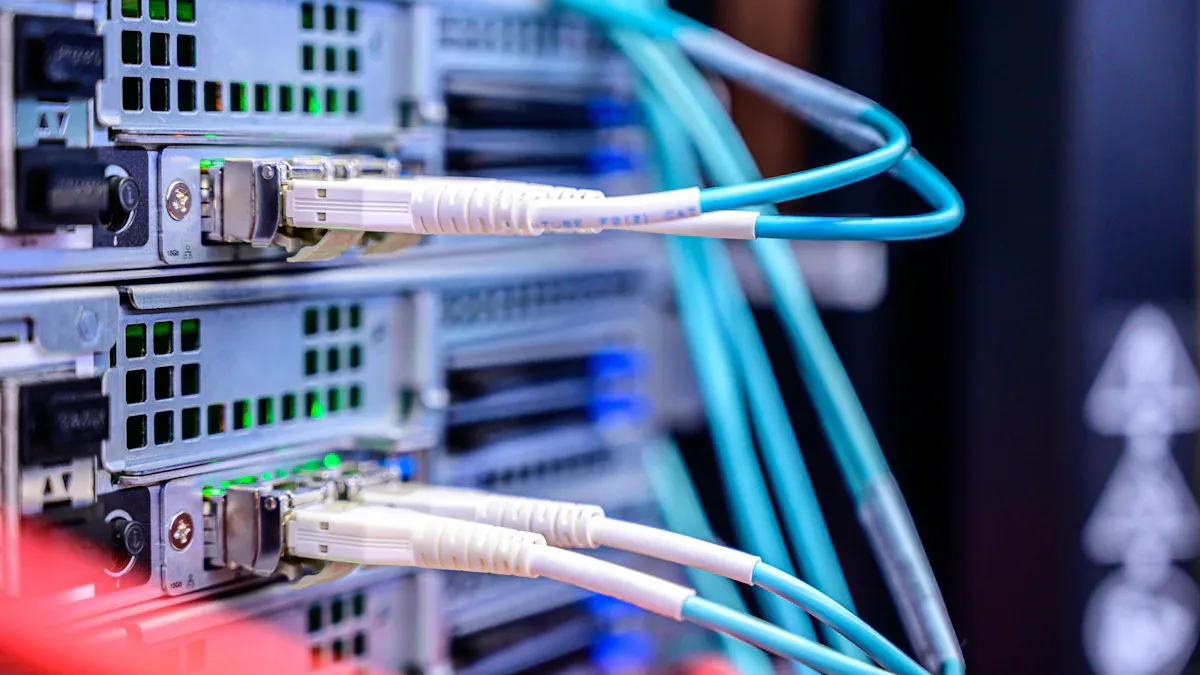

A high-performing server plays a vital role in delivering a smoother user experience. Users expect website loading times to be quick, often under three seconds. Delays beyond this can lead to higher bounce rates, reduced conversions, and lost revenue. To optimize server performance, faster operations not only improve overall performance but also boost SEO rankings, as Google prioritizes speed for better UX. For businesses, optimizing server performance can significantly enhance customer satisfaction and growth. Ensuring your server runs optimally guarantees maximum performance and keeps users engaged.
Key Takeaways
A fast server helps websites load quickly, under three seconds, keeping users happy.
Server tuning means adjusting hardware and software to work better and use fewer resources.
Use caching, like browser and server caching, to get data faster and make websites smoother.
Make databases better by fixing queries and adding indexes to find data quickly and lower server work.
A Content Delivery Network (CDN) makes loading faster by sending content from nearby servers.
Check server performance often to spot problems early and keep it running well.
Load balancing shares traffic between servers, stopping overload and keeping things steady during busy times.
Better hosting gives more power and room to grow, making servers faster and more reliable.
Understanding Server Optimization
What Is Server Optimization?
Server optimization refers to the process of fine-tuning your server’s hardware, software, and configurations to ensure it operates at peak efficiency. This involves improving response times, reducing resource usage, and maximizing uptime. By optimizing your server, you can handle more traffic, deliver faster load times, and provide a better user experience.
For example, techniques like dynamic resource allocation and load balancing play a critical role in this process. Dynamic resource allocation adjusts server resources based on real-time demand, ensuring efficiency. Load balancing distributes workloads across multiple servers, which has been shown to improve performance by up to 40%. These strategies not only enhance performance but also ensure your server remains reliable during traffic spikes.
Optimization Strategy | Evidence Supporting Effectiveness | Improvement Percentage |
|---|---|---|
Dynamic Resource Allocation | Improves efficiency and performance by adjusting resources based on real-time demand. | N/A |
Load Balancing | Enhances system performance by distributing workloads, shown to improve performance by 40%. | 40% |
Why Is Server Optimization Important?
Optimizing your server is essential for maintaining a fast and reliable website. A well-optimized server ensures quick response times, which directly impacts user satisfaction and search engine rankings. Google prioritizes websites with faster load times, making server optimization a key factor for SEO success.
Additionally, server optimization helps you avoid common pitfalls like downtime and slow performance. For instance, predictive analytics can reduce downtime by 25% and improve overall performance by 15%. This proactive approach ensures your server can handle evolving demands without compromising efficiency. Organizations that implement robust capacity planning practices report 20% fewer performance-related issues, highlighting the importance of staying ahead of potential problems.
Metric | Importance |
|---|---|
Accurate Performance Evaluation | Enables evaluation of virtual server performance against workload demands. |
Resource Optimization | Helps identify efficient resource allocation to avoid oversizing or undersizing servers. |
Identifying Bottlenecks | Reveals performance bottlenecks that could disrupt operations. |
Common Causes of Poor Web Server Performance
Several factors can lead to poor web server performance. One common issue is poor load distribution, where traffic is not evenly spread across servers, causing slow response times. Default configurations also contribute to inefficiencies, as they may not suit the specific needs of your environment. DNS and network connectivity problems can further slow down access, frustrating users.
Another major cause is unoptimized code. Inefficient code increases server load, leading to slower performance. Running load tests can help you identify these issues and understand your server’s capacity. Traffic spikes also pose a challenge, especially for unprepared systems. Implementing load balancing and auto-scaling can mitigate these risks.
Problem | Description |
|---|---|
Poor Load Distribution | Slow response times due to incorrect server assignment for new visitors. |
Default Configurations | Systems must be properly tuned; default settings may not suit live environments. |
DNS and Network Connectivity | DNS issues can prevent access, leading to errors and slowdowns. |
Troublesome Third-Party Services | Slowdowns from external services can affect user experience. |
Tip: Regularly monitor your server’s performance metrics to identify and address these issues before they escalate.
Actionable Steps to Optimize Server Performance
Enable Caching for Faster Response Times
Caching is one of the most effective ways to increase server speed and improve user experience. By storing frequently accessed data in temporary storage, caching reduces the need for servers to process repetitive requests. This approach minimizes server load and significantly speeds up response times.
There are several types of caching you can implement:
Browser Caching: Stores static files like images, CSS, and JavaScript on the user’s device, reducing the need to download them repeatedly.
Server-Side Caching: Uses technologies like Memcached or Redis to store database query results or API responses in memory for faster retrieval.
Content Delivery Network (CDN) Caching: Caches content on servers closer to the user, reducing latency and improving load times.
For example, Memcached is a high-performance caching system that stores web files in shared memory. This reduces data access latency and improves server responsiveness. Similarly, using Nginx as a caching layer for static files can offload requests from your primary server, allowing it to focus on dynamic content.
Caching Technology | Description | Impact on Performance |
|---|---|---|
Memcached | A distributed memory object caching system that reduces data access latency. | Improves server responsiveness by enabling faster access to frequently requested data. |
Nginx | A high-performance HTTP server that efficiently serves static files. | Enhances server responsiveness by offloading static file requests from the main server. |
Tip: Regularly review your cache management strategy to ensure it aligns with your website’s needs and traffic patterns.
Optimize Databases for Efficiency
Databases play a critical role in server performance. Poorly optimized databases can slow down your server and negatively impact user experience. To optimize databases, focus on improving query performance, indexing, and caching.
Here are some practical steps to optimize database performance:
Optimize Queries: Rewrite inefficient SQL queries to reduce execution time. For example, avoid using SELECT * and instead specify the required columns.
Indexing: Create indexes on frequently queried columns to speed up data retrieval.
Database Caching: Use tools like Redis or Memcached to cache query results and reduce database load.
Regular Maintenance: Perform routine tasks like defragmenting tables and removing unused indexes to keep your database running smoothly.
Case studies highlight the benefits of database optimization. For instance, Target implemented a data strategy that connected various systems, leading to a 27% increase in same-store sales within two years. Similarly, Siemens reduced unplanned downtime by 75% through data-driven decision-making.
Organization | Improvement Description | Result/Impact |
|---|---|---|
Target | Integrated data strategy connecting various systems | 27% increase in same-store sales within two years |
Siemens | Data-driven decision making in industrial settings | 75% reduction in unplanned downtime |
Note: Regularly monitor your database performance using tools like MySQL Query Analyzer to identify and resolve bottlenecks.
Use a Content Delivery Network (CDN)
A Content Delivery Network (CDN) is a network of servers distributed across multiple locations. It stores cached versions of your website’s content and delivers them to users from the server closest to their location. This reduces latency, improves load times, and enhances server speed.
Implementing a CDN offers several benefits:
Faster Load Times: By serving content from nearby servers, a CDN reduces the time it takes for users to access your website.
Improved Reliability: CDNs distribute traffic across multiple servers, preventing overload and ensuring high availability.
Enhanced Security: Many CDNs include built-in security features like DDoS protection and SSL encryption.
For example, an e-commerce site that reduced its load time from 5 seconds to 1.8 seconds using a CDN saw a 20% increase in revenue. Similarly, a SaaS platform achieved 99.99% uptime and fewer security incidents after implementing a CDN.
Case Study | Load Time Reduction | Revenue Increase | User Engagement Improvement | Uptime Improvement | Security Enhancement |
|---|---|---|---|---|---|
Ecommerce Site | 5s to 1.8s | 20% increase | Decreased bounce rate | N/A | N/A |
SaaS Platform | N/A | N/A | N/A | 99.99% uptime | Fewer security incidents |
Tip: Choose a CDN provider that aligns with your website’s requirements and offers features like real-time analytics and customizable caching rules.
Reduce File Sizes to Minimize Load
Reducing file sizes is a crucial step to increase server speed and improve user experience. Large files take longer to load, placing unnecessary strain on your server. By minimizing file sizes, you can optimize server performance and ensure faster response times.
Here are some effective strategies to reduce file sizes:
Minimize HTTP Requests: Combine and minify CSS, JavaScript, and HTML files. This reduces the number of requests your server needs to handle, speeding up load times.
Optimize Images: Resize images, choose efficient formats like WebP, and implement lazy loading. These techniques reduce image file sizes and improve loading speed.
Use Compression: Enable Gzip or Brotli compression on your server. These tools compress files before sending them to users, reducing data transfer time.
For example, minimizing HTTP requests by combining scripts and stylesheets can significantly enhance server speed. Similarly, optimizing images by resizing and lazy loading ensures faster rendering. These methods not only reduce server load but also improve user satisfaction.
Tip: Regularly audit your website’s files to identify and remove unnecessary assets. This keeps your server lean and efficient.
Upgrade Hosting Solutions for Better Performance
Your hosting solution plays a pivotal role in server optimization. If your website experiences slow response times or frequent downtime, it may be time to upgrade your hosting plan. Advanced hosting options provide better resources and scalability, ensuring your server can handle increased traffic.
Different hosting solutions offer varying benefits:
Shared Hosting: Suitable for small websites but may struggle with high traffic.
VPS Hosting: Provides dedicated resources, offering better performance than shared hosting.
Dedicated Hosting: Ideal for large websites requiring maximum control and resources.
Cloud Hosting: Offers scalability and reliability, making it perfect for growing businesses.
Faster websites foster trust and encourage customer retention. Nearly 70% of online shoppers abandon their carts due to poor website performance. Upgrading to a managed or cloud hosting solution can enhance server speed and scalability, leading to higher conversion rates and increased revenue.
Note: Google evaluates website speed as a ranking factor. Upgrading your hosting solution can improve metrics like Core Web Vitals, boosting your SEO performance.
Implement Load Balancing to Distribute Traffic
Load balancing is essential for maintaining server stability during high-traffic periods. It distributes incoming requests across multiple servers, preventing any single server from becoming overwhelmed. This ensures consistent performance and minimizes downtime.
Load balancing proves especially effective in high-traffic environments:
E-commerce Platforms: During flash sales, load balancers manage traffic spikes, ensuring stable shopping experiences.
SaaS Applications: Viral adoption can lead to sudden user growth. Load balancers dynamically allocate requests, preventing performance degradation.
For example, an e-commerce platform using load balancing during Black Friday sales can handle intense traffic spikes without crashing. Similarly, SaaS apps experiencing viral growth benefit from dynamic traffic distribution, ensuring smooth user experiences.
Tip: Choose a load balancer that supports your server’s architecture and traffic patterns. This ensures optimal performance and reliability.
How to Monitor and Improve Server Response Time


Monitoring server performance is essential for ensuring your website delivers a seamless user experience. By keeping track of key metrics, using the right tools, and setting up alerts, you can identify and resolve issues before they impact users. This proactive approach helps you optimize server performance and improve server response time effectively.
Key Metrics for Monitoring Web Server Performance
To monitor web server performance, you need to focus on specific metrics that provide insights into your server’s health and efficiency. These metrics help you understand how well your server is performing and where improvements are needed.
Metric | Description |
|---|---|
User Satisfaction | Also known as Apdex Scores, it quantifies user satisfaction through a mathematical formula. |
Time to First Byte | Measures the time taken to render the application on end-user devices. |
Time to First Paint | Indicates how long it takes for the initial pixels to appear on the screen. |
Speed Index | Assesses how quickly the above-the-fold content is displayed. |
Time to Interactive | Measures the duration before a web page becomes fully interactive. |
DNS Lookup Time | Tracks the time required for a domain lookup during page loading. |
Error Rate | Monitors the percentage of request issues relative to the total number of requests. |
Peak Response Time | Records the longest response time for a set number of requests processed by the server. |
By regularly tracking these metrics, you can identify bottlenecks and areas that require server optimization. For example, a high DNS lookup time may indicate issues with your domain configuration, while a low Apdex Score suggests users are experiencing delays.
Tip: Focus on metrics like Time to First Byte and Speed Index to improve server response time and enhance user satisfaction.
Tools for Tracking and Analyzing Server Performance
Using the right tools simplifies the process of monitoring server performance. These tools provide real-time data, detailed reports, and actionable insights to help you optimize server performance.
Tool | Key Features | Best For | Pricing |
|---|---|---|---|
Real-time monitoring of CPU, memory, disk usage, and load average. | Businesses looking for a free, user-friendly server monitoring control panel. | Free (no hidden costs) | |
SolarWinds | Application performance monitoring and automated alerts. | Enterprises needing detailed server and application monitoring. | Starts at $2,995/year |
Datadog | AI-driven insights and customizable dashboards. | Businesses with hybrid or multi-cloud environments. | Starts at $15/host/month |
Zabbix | Open-source monitoring with strong community support. | Small to medium-sized businesses with in-house IT expertise. | Free (open source) |
ManageEngine | Unified monitoring for servers, networks, and applications. | IT teams managing diverse infrastructures. | Starts at $245/year for 10 devices |
Nagios XI | Plugin-based architecture for flexibility. | Organizations needing extensive customization. | Starts at $1,995/year |
PagerDuty | Incident management and real-time server health tracking. | Teams focusing on incident response. | Starts at $23/user/month |
Dotcom-Monitor | Website, API, and protocol monitoring included. | Businesses needing all-in-one monitoring solutions. | Starts at $19/month per target |
Prometheus | Open-source monitoring with powerful visualization tools. | DevOps teams working in containerized or cloud-native environments. | Free (open source) |
For example, Datadog’s AI-driven insights can help you detect anomalies in server performance, while Zabbix offers a cost-effective solution for small businesses. Choose a tool that aligns with your technical expertise and infrastructure needs.
Note: Tools like CloudPanel and Prometheus are excellent for beginners, while SolarWinds and Datadog cater to advanced monitoring requirements.
Setting Alerts for Performance Issues
Alerts play a crucial role in server monitoring and optimization. They notify you of potential problems, allowing you to address them before they escalate. Setting up an effective alert system ensures your server remains reliable and responsive.
Here are some strategies for setting alerts:
Early Detection: Configure alerts to detect issues like high CPU usage or slow response times. This helps you resolve problems before they affect users.
Custom Thresholds: Set performance thresholds for metrics like Time to First Byte or Peak Response Time. Alerts will trigger when these thresholds are exceeded.
Scalable Monitoring: Design a monitoring strategy that grows with your infrastructure. Define clear objectives and processes for resolving alerts.
For example, Cisco Systems uses proactive monitoring to achieve 99.999% uptime by setting clear KPIs and alert protocols. Similarly, Google’s SRE teams prioritize incidents based on severity, ensuring critical issues receive immediate attention.
Continuous monitoring also helps you predict future risks. Advanced algorithms analyze trends and forecast potential problems, enabling you to take preventive action. This approach not only improves server response time but also enhances overall server reliability.
Tip: Use tools like PagerDuty or ManageEngine to implement real-time alerts and streamline incident management.
Troubleshooting Server Performance Issues
Identifying and Resolving Bottlenecks
Bottlenecks can severely impact web server performance by limiting the system’s ability to handle requests efficiently. Identifying these bottlenecks is the first step toward resolving them. Start by using server monitoring tools to track metrics like CPU usage, memory consumption, and disk I/O. Tools such as PerfMon and DebugDiag can help you pinpoint areas where performance slows down. For example, PerfMon collects system-wide data, while DebugDiag provides detailed analysis of resource usage.
Once you identify the bottleneck, take targeted action. If high CPU usage is the issue, optimize your server’s workload by redistributing tasks or upgrading hardware. For memory-related bottlenecks, consider increasing RAM or optimizing applications to use memory more efficiently. Benchmarking tools like Apache JMeter and Gatling can simulate traffic and help you test the effectiveness of your solutions.
Tool Name | Description | Use Case |
|---|---|---|
Apache JMeter | Open-source tool for load, performance, and benchmark testing. | Web applications |
Gatling | Supports distributed testing and real-time reporting. | Load testing |
Grinder | Versatile framework for benchmark tests on various systems. | Web apps, databases |
Tip: Regularly benchmark your server to ensure that bottlenecks are resolved and performance remains optimal.
Addressing High Resource Usage
High resource usage often leads to slow server response times and degraded user experience. To address this, you need to monitor server resource usage consistently. Tools like PerfView and BenchmarkDotNet can help you analyze resource consumption and identify areas for improvement. PerfView, for instance, pinpoints specific methods causing slowdowns, while BenchmarkDotNet compares different modules to determine the most efficient ones.
Here are three steps to tackle high resource usage:
Monitor server resource usage regularly to identify trends.
Address performance bottlenecks by optimizing applications or upgrading hardware.
Implement optimization techniques like caching and load balancing to reduce server strain.
Metric | Description |
|---|---|
Resource Usage | Shows the percentage of CPU, memory, and disk resources being utilized. |
Bottleneck | Identifies areas where performance is hindered due to high resource usage. |
Optimization Tips | Provides actionable strategies to improve server performance. |
Proactively monitoring CPU and bandwidth usage can prevent performance issues. For example, optimizing bandwidth by compressing files and enabling caching reduces server load. These strategies not only improve server performance but also enhance user satisfaction.
Note: High resource usage often signals inefficiencies in your system. Address these promptly to maintain optimal performance.
Fixing Slow Server Response Times
Slow server response times frustrate users and harm your website’s reputation. To troubleshoot a slow server, focus on improving Time to First Byte (TTFB), as it directly affects page speed. A faster TTFB reduces bounce rates and keeps users engaged. Implementing a Content Delivery Network (CDN) can cut response times by up to 70%, while regular database maintenance ensures efficient data retrieval.
Additionally, bot management techniques can reduce unnecessary server load. For instance, rate limiting decreases server strain by up to 30%, while IP filtering blocks unwanted traffic. These methods free up resources for legitimate users, improving overall performance.
Bot Management Technique | Impact |
|---|---|
Rate Limiting | Cuts server load by up to 30%. |
IP Filtering | Reduces unnecessary traffic. |
Bot Detection Rules | Boosts access for real users. |
Tip: Combine server monitoring and optimization strategies to maintain fast response times and a seamless user experience.
Best Practices for Long-Term Server Optimization
Regular Maintenance and Updates
Regular maintenance ensures your server remains efficient and reliable. By keeping your server updated, you reduce the risk of vulnerabilities and improve overall performance. Maintenance tasks include updating software, applying security patches, and cleaning up unused files. These actions prevent issues like slow response times and downtime.
Digitizing Standard Operating Procedures (SOPs can streamline maintenance processes. With digital SOPs, you access guidelines quickly, reducing miscommunication and ensuring consistency. This approach improves workflow and minimizes errors. For example:
Digitized SOPs enhance access to maintenance guidelines, reducing dependency on physical documents.
Consistent processes lead to improved quality and fewer mistakes.
Another effective strategy is using a Maintenance Decision Support System (MDSS). MDSS helps optimize resource use, improve traffic safety, and reduce delays. These benefits highlight the importance of regular server upkeep.
Tip: Schedule routine maintenance checks to identify and resolve issues before they escalate.
Planning for Scalability and Traffic Spikes
Scalability ensures your server can handle increased traffic without compromising performance. Planning for traffic spikes involves implementing strategies like load balancing and auto-scaling. Load balancing distributes requests across multiple servers, preventing crashes and improving user experience. High-traffic platforms like Amazon and Netflix use this method to maintain reliability.
Auto-scaling adjusts the number of active servers based on demand. This ensures your server operates efficiently during peak periods. Proactive monitoring and stress testing help identify bottlenecks, allowing you to optimize system performance.
Scalability Type | Description | Examples |
|---|---|---|
Horizontal Scaling | Adds more machines to handle increased traffic and data volume. | Cassandra, MongoDB |
Vertical Scaling | Upgrades existing server resources for short-term growth. | MySQL (Amazon RDS) |
Failover mechanisms also play a key role in scalability. They ensure applications remain operational during server failures, maintaining a seamless user experience.
Note: Plan for scalability early to avoid disruptions during traffic spikes.
Continuous Performance Testing and Tuning
Continuous performance testing helps you identify and resolve issues before they impact users. Integrating testing into your team culture promotes collaboration and experimentation. Automated tests triggered by new code changes ensure ongoing quality.
Effective testing strategies include:
Formulate a Goal: Align testing priorities with business objectives.
Dynamic Testing: Use infrastructure as code for flexible environments.
Resiliency Testing: Implement chaos engineering to test system resilience.
Version Control: Align test scripts with application codebase versions.
Cross-Environment Analysis: Test performance across different platforms.
For example, including performance testing in user stories raises awareness among developers. Automated tests in build pipelines provide quick feedback, ensuring your server remains optimized.
Tip: Use Application Performance Management (APM) tools to track metrics and improve server optimization.
Optimizing server performance is essential for faster response times and overall efficiency. It enhances user satisfaction, improves SEO rankings, and drives business growth. By enabling caching, optimizing databases, and using a CDN, you can significantly improve server performance. Monitoring tools and proactive troubleshooting ensure your server remains reliable. Performance analytics reveal that server optimization boosts revenue, reduces costs, and fosters innovation. These benefits highlight its role in business success. Start implementing these strategies today to deliver a seamless user experience and achieve long-term operational excellence.
FAQ
1. What is server response time?
Server response time measures how long it takes for your server to respond to a user’s request. Faster response times improve user experience and search engine rankings.
2. How does caching improve server performance?
Caching stores frequently accessed data temporarily. This reduces the need for repeated processing, speeds up response times, and minimizes server load.
3. Should you upgrade your hosting plan for better performance?
Yes, upgrading to VPS, dedicated, or cloud hosting provides more resources and scalability. This ensures your server can handle traffic spikes efficiently.
4. What tools can you use to monitor server performance?
Tools like Datadog, Zabbix, and SolarWinds provide real-time insights into server health. They help you identify bottlenecks and optimize performance.
5. How can you reduce file sizes to improve server speed?
Minify CSS, JavaScript, and HTML files. Compress images using formats like WebP. Enable Gzip or Brotli compression to reduce data transfer time.
6. What is load balancing, and why is it important?
Load balancing distributes incoming traffic across multiple servers. This prevents overload, ensures stability, and maintains consistent performance during high-traffic periods.
7. How often should you perform server maintenance?
Perform server maintenance regularly, such as weekly or monthly. Update software, apply security patches, and clean up unused files to ensure optimal performance.
8. Can a CDN improve server response times?
Yes, a CDN delivers cached content from servers closer to users. This reduces latency, speeds up load times, and enhances server reliability.






